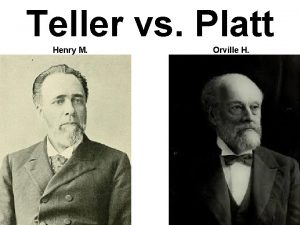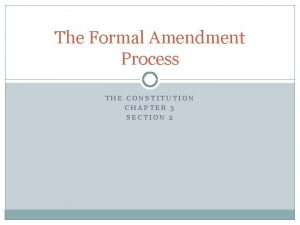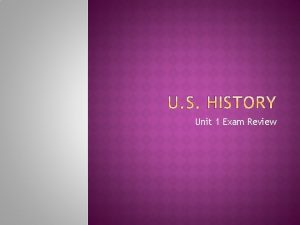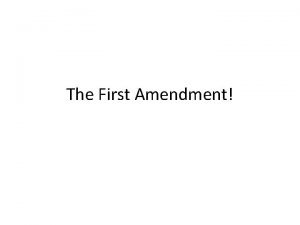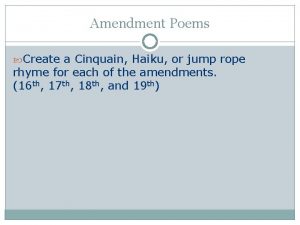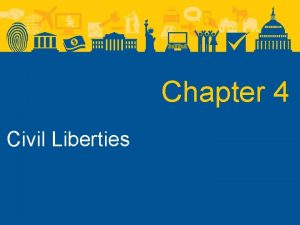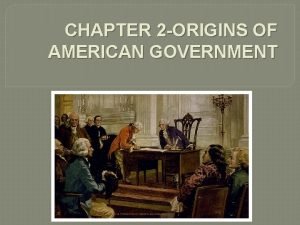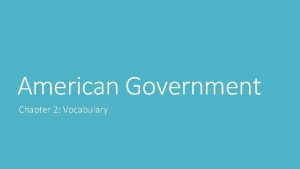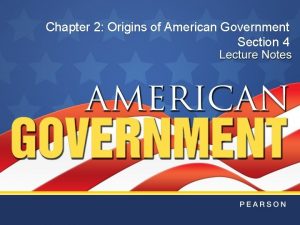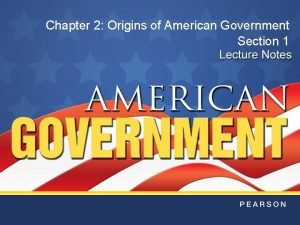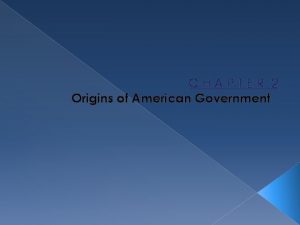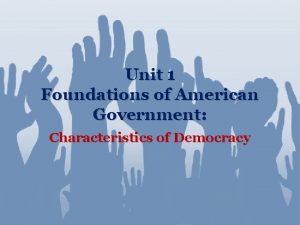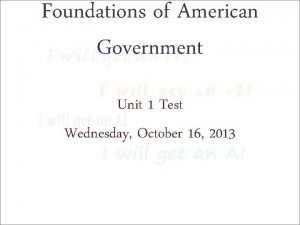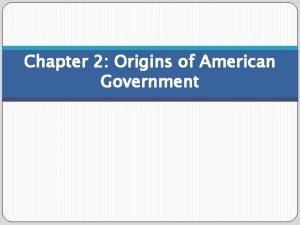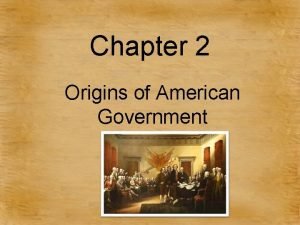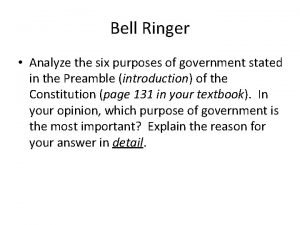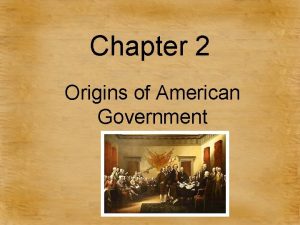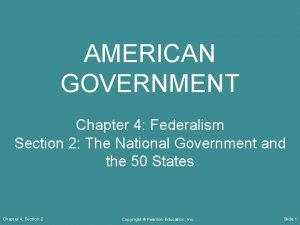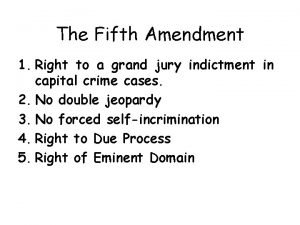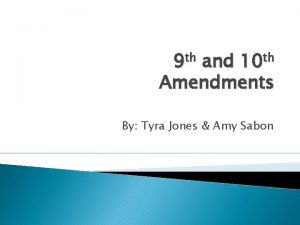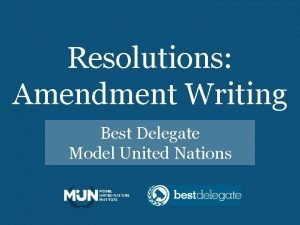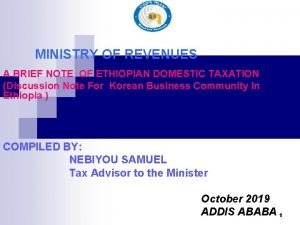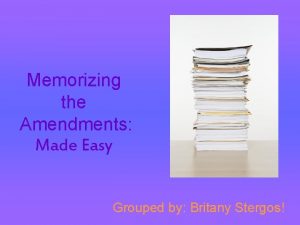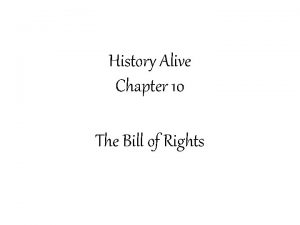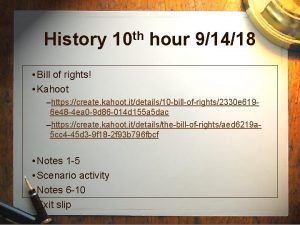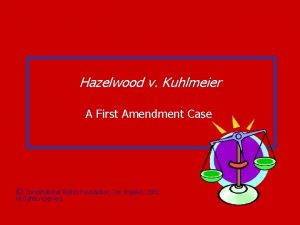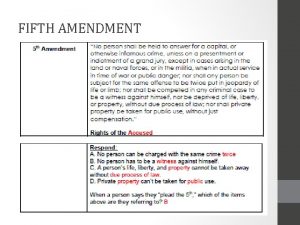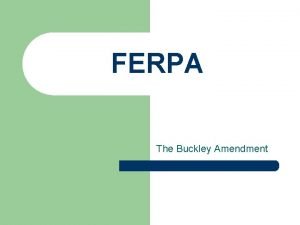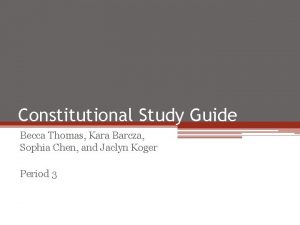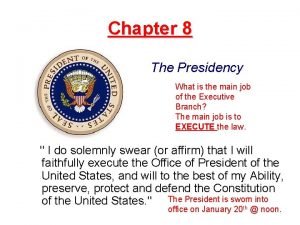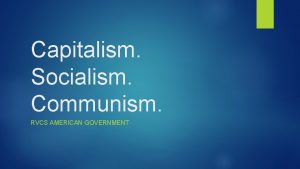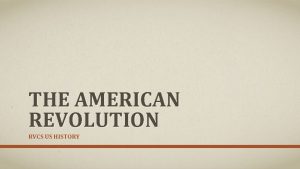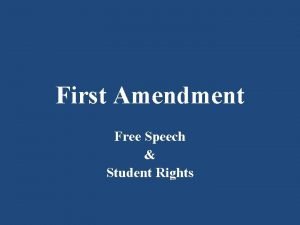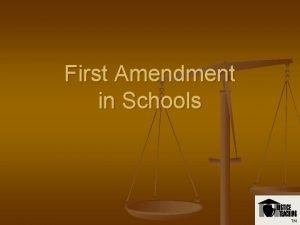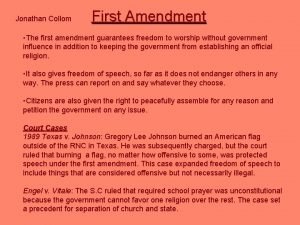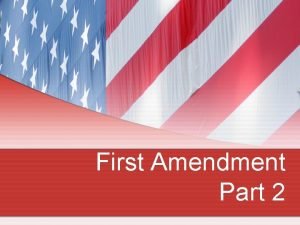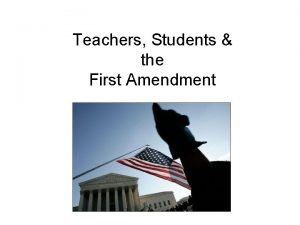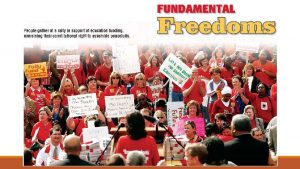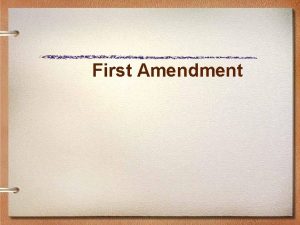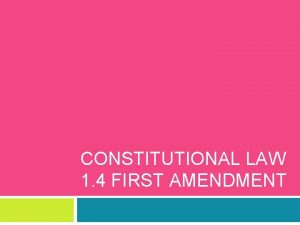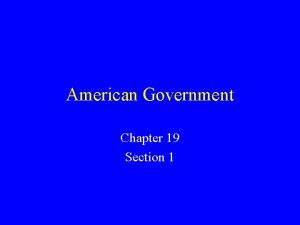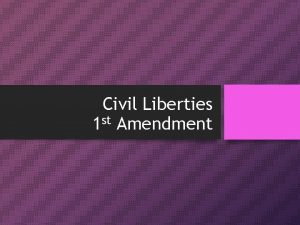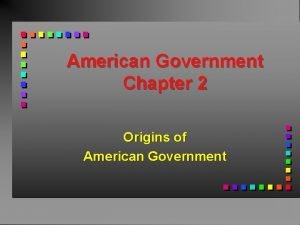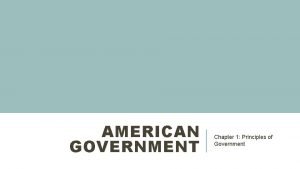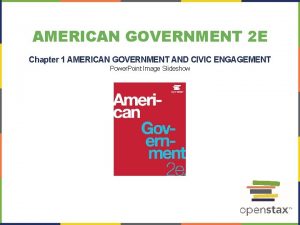The First Amendment RVCS American Government The First


![The First Amendment (Original Source) [1] Congress shall make no law respecting an establishment The First Amendment (Original Source) [1] Congress shall make no law respecting an establishment](https://slidetodoc.com/presentation_image_h2/74c74caaa98ea0ff69809fa01cf8e768/image-3.jpg)


![“Separation of Church and State” [From Thomas Jefferson to the Danbury Baptist Association] “Believing “Separation of Church and State” [From Thomas Jefferson to the Danbury Baptist Association] “Believing](https://slidetodoc.com/presentation_image_h2/74c74caaa98ea0ff69809fa01cf8e768/image-6.jpg)

![Case Studies (Video) [Video] https: //www. youtube. com/watch? v=3 Qpudv. LECw. U Case Studies (Video) [Video] https: //www. youtube. com/watch? v=3 Qpudv. LECw. U](https://slidetodoc.com/presentation_image_h2/74c74caaa98ea0ff69809fa01cf8e768/image-8.jpg)
![Town Hall Video (NON TOPIC) [video] https: //www. youtube. com/watch? v=npn 4 FPGw. Yu. Town Hall Video (NON TOPIC) [video] https: //www. youtube. com/watch? v=npn 4 FPGw. Yu.](https://slidetodoc.com/presentation_image_h2/74c74caaa98ea0ff69809fa01cf8e768/image-9.jpg)

















![Freedom of the Press [The UN’s “Universal Declaration of Human Rights”] “Everyone has the Freedom of the Press [The UN’s “Universal Declaration of Human Rights”] “Everyone has the](https://slidetodoc.com/presentation_image_h2/74c74caaa98ea0ff69809fa01cf8e768/image-27.jpg)
![Case Study Peyton Manning & Al Jazeera [Video, start at 1 min] https: //www. Case Study Peyton Manning & Al Jazeera [Video, start at 1 min] https: //www.](https://slidetodoc.com/presentation_image_h2/74c74caaa98ea0ff69809fa01cf8e768/image-28.jpg)





- Slides: 33

The First Amendment RVCS American Government

The First Amendment (Original Source) Congress shall make no law respecting an establishment of religion, or prohibiting the free exercise thereof; or abridging the freedom of speech, or of the press; or the right of the people peaceably to assemble, and to petition the government for a redress of grievances.
![The First Amendment Original Source 1 Congress shall make no law respecting an establishment The First Amendment (Original Source) [1] Congress shall make no law respecting an establishment](https://slidetodoc.com/presentation_image_h2/74c74caaa98ea0ff69809fa01cf8e768/image-3.jpg)
The First Amendment (Original Source) [1] Congress shall make no law respecting an establishment of religion, or prohibiting the free exercise thereof; [2] or abridging the freedom of speech, [3] or of the press; [4] or the right of the people peaceably to assemble, [5] and to petition the government for a redress of grievances.

Part 1: Freedom of Religion

Religious Freedom Clause 1: “Congress shall make no laws respecting an establishment of religion…” The key principle = The federal government will not create a statesponsored church/religion. (the word “respect” originally meant “prefer”) Clause 2: “or prohibiting the free exercise thereof. ” The key principle = The federal government will not make laws that hinder a citizen to practice his/her religion.
![Separation of Church and State From Thomas Jefferson to the Danbury Baptist Association Believing “Separation of Church and State” [From Thomas Jefferson to the Danbury Baptist Association] “Believing](https://slidetodoc.com/presentation_image_h2/74c74caaa98ea0ff69809fa01cf8e768/image-6.jpg)
“Separation of Church and State” [From Thomas Jefferson to the Danbury Baptist Association] “Believing with you that religion is a matter which lies solely between man and his God, ” the First Amendment, which was affirmed by “the whole American people, ” was for “building a wall of separation between church and State. ”

“Separation of Church and State” Clarification—The phrase “Separation of Church and State” is not in the U. S. Constitution. This was merely a commentary by Thomas Jefferson on the 1 st Amendment’s Original Intention—The State (government) will stay out of the affairs of local churches, and likewise, local churches will not be able to dominate other churches or individual citizens. Secular Reinterpretation—Religion has no place in public affairs.
![Case Studies Video Video https www youtube comwatch v3 Qpudv LECw U Case Studies (Video) [Video] https: //www. youtube. com/watch? v=3 Qpudv. LECw. U](https://slidetodoc.com/presentation_image_h2/74c74caaa98ea0ff69809fa01cf8e768/image-8.jpg)
Case Studies (Video) [Video] https: //www. youtube. com/watch? v=3 Qpudv. LECw. U
![Town Hall Video NON TOPIC video https www youtube comwatch vnpn 4 FPGw Yu Town Hall Video (NON TOPIC) [video] https: //www. youtube. com/watch? v=npn 4 FPGw. Yu.](https://slidetodoc.com/presentation_image_h2/74c74caaa98ea0ff69809fa01cf8e768/image-9.jpg)
Town Hall Video (NON TOPIC) [video] https: //www. youtube. com/watch? v=npn 4 FPGw. Yu. Y

Part 2: Freedom of Speech

Basics of Free Speech Every American wants the right to speak freely But…. Some Americans want to deny others their right to speak freely if they disagree with their views Ex. Religion (or Irreligion), War, Politics

Courts Distinguish Different Types of Speech 1 - Verbal (words/text) 2 - Non-verbal (symbols, but not words)

Pure Speech Definition—Verbal expression of thought or opinion before an audience that has chosen to listen. Examples—Dinner table, church, political gatherings, etc.

Symbolic Speech Definition—Using actions or symbols, with or without words, to express opinions. Ex: Burning US flags to protest Vietnam War Restrictions: Courts have ruled that the 1 st Amendment does not permit actions that threaten public safety

Tinker v. Des Moines (1969) • Students wore black arm bands to protest the Vietnam War. • The students were suspended from school for violating the school’s dress code. • Their parents sued the school district! • The Tinkers claimed suspension violated their first amendment right to Free Speech. • What do you think? Can the school district tell kids what they can and can not wear?

The Verdict Tinker v. Des Moines (1969)-The Supreme Court ruled that students could wear black armbands in protest of Vietnam war. What type of speech is this case?

Regulating Speech Rights Of Free Speech Need To Protect Society

The Supreme Court’s Decisions— Based on 3 Views

View 1: The “Clear and Present Danger” Issue “Clear and Present Danger”- if speech presents an immediate danger it is not protected by the 1 st amendment Ex. Public Safety Issue- Terrorist Threat

View 2: The “Bad Tendency Doctrine” Definition—This belief advocates that if speech might lead to illegal action, it should be prohibited. Q: What do supporters of this view consider more important, maintaining social order or protecting basic freedoms? A: Maintaining Social Order

View 3: The “Preferred Position Doctrine” Definition--1 st Amendment freedoms are more fundamental than any other freedoms. So… if a law prohibits freedoms it must be absolutely necessary or it is unconstitutional

Types of Speech Not Always Protected 1. Defamatory Speech- false speech that damages a person’s good name, character, or reputation Two Types 1. Slander- Spoken 2. Libel- written

Types of Speech Not Always Protected 2. “ Fighting Words ”- insulting words that provoke immediate violence “any offensive, derisive, or annoying word to any other person who is lawfully in any street or public place”

Types of Speech Not Always Protected 3. Student Speech- profane and indecent speech on school property or at school events is subject to suspension [Public Schools] The same speech is protected outside school

Student Speech Tinker v. Des Moines- ruled that students do not give up all their freedoms in school Bethel School District v. Fraser (1986)- ruled that school officials can decide what manner of speech is appropriate in public schools Court established a distinction between 1. Student’s personal expression 2. Speech appropriate in school

Part 3: Freedom of the Press
![Freedom of the Press The UNs Universal Declaration of Human Rights Everyone has the Freedom of the Press [The UN’s “Universal Declaration of Human Rights”] “Everyone has the](https://slidetodoc.com/presentation_image_h2/74c74caaa98ea0ff69809fa01cf8e768/image-27.jpg)
Freedom of the Press [The UN’s “Universal Declaration of Human Rights”] “Everyone has the right to freedom of opinion and expression; this right includes freedom to hold opinions without interference, and impart information and ideas through any media regardless of frontiers. ” The Press—This includes freelance journalists, newspapers, television reports, bloggers, and any other form of media that communicates news and/or information. Legal Problems—The press is not free to plagiarize other sources (they must give the due credit). It is also tricky to distinguish between libel and mere criticism. Usually, “malicious intent” needs to be proven.
![Case Study Peyton Manning Al Jazeera Video start at 1 min https www Case Study Peyton Manning & Al Jazeera [Video, start at 1 min] https: //www.](https://slidetodoc.com/presentation_image_h2/74c74caaa98ea0ff69809fa01cf8e768/image-28.jpg)
Case Study Peyton Manning & Al Jazeera [Video, start at 1 min] https: //www. youtube. com/watch? v=m. YOAY 8 b. MLbs

Part 4: Freedom of Assembly

Freedom of Assembly Protests—The most common manifestation of this freedom is seen in public protests. Major Challenge—How can we distinguish between a peaceful assembly and a “disturbance of the peace”? Clarification—Citizens do not have the right to assemble on “private” property. But they can on “public” property.

Part 5: Freedom to Petition the Government

Petition Old Origins—This particular freedom goes all the way back to the Magna Carta. Petition—This word means to file a complaint, and to appeal a particular issue.

“Good Night and Good Luck” M 9: 02 M 13: 59 M 27: 56 M 32: 16 -18 M 56: 56 M 1: 11: 30
 Platt amendment vs teller amendment
Platt amendment vs teller amendment Formal amendment chapter 3 section 2
Formal amendment chapter 3 section 2 Which statement best summarizes this speech?
Which statement best summarizes this speech? Splc first amendment quiz
Splc first amendment quiz 4th amendment poem
4th amendment poem Chapter 19 civil liberties first amendment freedoms
Chapter 19 civil liberties first amendment freedoms Civil liberties first amendment freedoms
Civil liberties first amendment freedoms National powers
National powers Chapter 2 american government
Chapter 2 american government Origins of american government vocabulary
Origins of american government vocabulary Origins of american government section 4
Origins of american government section 4 Chapter 2 origins of american government answer key
Chapter 2 origins of american government answer key Chapter 2 origins of american government worksheet answers
Chapter 2 origins of american government worksheet answers Ap gov unit 1 study guide
Ap gov unit 1 study guide Unit 1 foundations of american government
Unit 1 foundations of american government Origins of american government section 1
Origins of american government section 1 Foundations of american government unit test
Foundations of american government unit test Origins of american government section 1
Origins of american government section 1 Chapter 2 lesson 1 origins of american government
Chapter 2 lesson 1 origins of american government What are the six purposes of government
What are the six purposes of government Chapter 2 origins of american government
Chapter 2 origins of american government Chapter 4 federalism answer key
Chapter 4 federalism answer key Property rights amendment
Property rights amendment Amendment 10 meaning
Amendment 10 meaning Friendly amendment mun
Friendly amendment mun Stamp duty(amendment) proclamation no. 612/2008
Stamp duty(amendment) proclamation no. 612/2008 Amendment 13
Amendment 13 History alive chapter 10 bill of rights answers
History alive chapter 10 bill of rights answers 9th amendment simplified
9th amendment simplified Hazelwood v. kuhlmeier case
Hazelwood v. kuhlmeier case 9th amendment meaning
9th amendment meaning Buckley amendment
Buckley amendment 15th amendment importance
15th amendment importance 25 amendment
25 amendment
